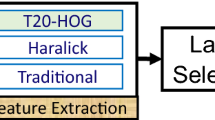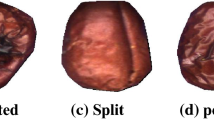Abstract
The current rice seed defect recognition methods have several disadvantages, including the background segmentation of images, complex operation, and non-normalization processing. In this study, we proposed a enhanced individual characteristics normalized lightweight Rice-Visual Geometry Group Network 16(Rice-VGG16) method for rice seed defect recognition. Firstly, rice seed defects are divided, and the image processing steps are used to standardize the seed images and construct the datasets. Secondly, the fifth max-pooling layer is modified to the ave-pooling layer, and the activation function is defined as Leaky Rectified Linear Units(Leaky-ReLU) to enhance the individual characteristics and improve the recognition accuracy. Then, a batch normalization layer is added after the last convolution layer of each convolution group, the first full connection layer is removed, the node number of the second full connection layer is modified to 1024, and the model parameters are fine-tuned to carry out model lightweight. Thus the normalized lightweight Rice-VGG16 model is constructed to improve recognition speed. Experimental results with real datasets demonstrated that: the model was able to accurately identify rice seed defects, with the training accuracy of 99.63% and the recognition accuracy of 99.51%; compared with traditional VGG16 model, since the amount of training parameters has been reduced by 79.88%,the proposed method can reduce the training time per epoch and the recognition time by 18.83%,13.59%, respectively. The proposed method can be used for rice seed defect recognition or accurate grain grading and breeding.









Similar content being viewed by others
Abbreviations
- A :
-
Overall accuracy of the model
- bin :
-
Pooled window
- BN:
-
Batch normalization
- CCD:
-
Charge-coupled device
- CMOS:
-
Complementary metal oxide semiconductor
- CNN:
-
Convolutional neural network
- FC:
-
Full connection layers
- FN :
-
False Negative
- FP :
-
False Positive
- HSI:
-
Hue-saturation-intensity
- LED:
-
Light emitting diode
- LRN:
-
Local response normalization
- Leaky-ReLU:
-
Leaky Rectified Linear Units
- MATLAB:
-
Matrix laboratory
- P :
-
Precision
- R :
-
Recall rate
- ReLU:
-
Rectified linear unit
- RD_SD:
-
Rice seed defect dataset
- RGD:
-
Random gradient descent
- S :
-
Specificity
- TN :
-
True negative
- TP :
-
True Positive
- VGG16:
-
Visual Geometry Group Network 16
- *:
-
Convolution
- \(\lambda\) :
-
Parameter of LeakyReLU
- γ, β :
-
Model learning parameters
- µ B :
-
Sample mean
- σ B :
-
Sample variance
- bin :
-
Pooled window
- \({BN}_{\gamma ,\beta }\left({x}_{i}\right)\) :
-
Output of Batch Normalization Layer
- i, j :
-
Size of the pooled window
- m :
-
Number of batches
- n i,j :
-
Number of pixels fixed in bin
- p 0 :
-
First pixel points in the pooled window
- P n :
-
Last pixel points in the pooled window
- x :
-
Sum of the input layer pixels
- x i :
-
the ith training sample
- y :
-
Pixel of the output layer
References
Alex K, Ilya S, Geoffrey EH (2017) Imagenet classification with deep convolutional neural networks. Commun ACM 60:84–90. https://doi.org/10.1145/3065386
Amin N, Amin TG, Zhang YD (2019)Image-based deep learning automated sorting of date fruit. Postharvest Biol Tec1 53:133–141. https://doi.org/10.1016/j.postharvbio.2019.04.003
Andrew LM, Awni YH, Andrew YN (2013) Rectifier nonlinearities improve neural network acoustic models. In: Proceedings of 2013 international conference on machine learning. Atlanta, Georgia, USA, pp 517-528. https://dl.acm.org/doi/proceedings/10.5555/2584691
Bao YD, Mi CX, Wu N, Liu F, He Y (2019) Rapid classification of wheat grain varieties using hyperspectral imaging and chemometrics. Appl Sci-Basel 9:1–15. https://doi.org/10.3390/app9194119
Bottou L (2010)Large-scale machine learning with stochastic gradient descent. In: Proceeding of the 19th international conference on computational statistics. Paris, France, pp 177 – 186. https://doi.org/10.1007/978-3-7908-2604-3_16
Cui X, Zhang PZhaoJ, Xu W, Ma W,Jin C (2019) Study on inspection of corn seed breakage based on machine vision. Agric Mech Res 41:28–33. https://doi.org/10.13427/j.cnki.njyi.2019.02.005
Desai SV, Balasubramanian VN, Fukatsu T, Ninomiya S, GuoW (2019) Automatic estimation of heading date of paddy rice using deep learning. Plant Methods 15:1–16. https://doi.org/10.1186/s13007-019-0457-1
Dubosclard P, Larnier S, Konik H, Herbulot A, Devy M (2015) Automated visual grading of grain kernels by machine vision. In: 12th international conference on quality control by artificial vision, Le Creusot, France, pp 1-8. https://doi.org/10.1117/12.2182793
Guo YM, ,Liu Y, Oerlemans A, Lao SY,Wu S, Lew MS (2016) Deep learning for visual under- standing: a review. Neurocomputing 187:27–48. https://doi.org/10.1016/j.neucom.2015.09.116
Huang S, Fan X, Sun L, Shen Y, Suo X (2019) Research on classification method of maize seed defect based on machine vision. J Sens 2019:1–9. https://doi.org/10.1155/2019/2716975
Ioffe S, Szegedy C (2015) Batch normalization: accelerating deep network training by reducing internal covariate shift. In: Proceedings of the 32nd international conference on machine learning, Lille, France, pp 1–11. http://proceedings.mlr.press/v37/ioffe15.pdf
Jihen A, Bassem B, Alsayed A (2017) A deep learning-based approach for banana leaf diseases classification. Lect Notes Info 266:79–88. http://btw2017.informatik.uni-stuttgart.de/slidesand-papers/E1-10/paper_web.pdf
Kamilaris A, Francesc X,Prenafeta B (2018) Deep learning in agriculture: a survey. Comput Electron Agr 147:70–90. https://doi.org/10.1016/jcompag201802016
Karen s, Andrew Z (2015) Very deep convolutional networks for large-scale image recognition. In: 3rd international conference on learning representations, ICLR 2015. San Diego, CA, USA, pp 1-14. https://dblp.org/rec/journals/corr/SimonyanZ14a
Ksh RS, Saurabh C (2020) A cascade network for the classification of rice grain based on single rice kernel. Complex Intell Syst 6:321–334. https://doi.org/10.1007/s40747-020-00132-9
Labatut V, Cherifi H (2011) Accuracy measures for the comparison of classifiers. In: The 5th international conference on information technology, Amman, Jordanie, pp 1–5. http://arxiv.org/ftp/arxiv/papers/1207/1207.3790.pdf
Liu ZH, Zihao L (2019) 2019. Soft-shell shrimp recognition based on an improved alexnet for quality evaluations. J Food Eng 266:109698. https://doi.org/10.1016/j.jfoodeng.2019.109698
Lurstwut B, Pornpanomchai C (2017) Image analysis based on color, shape and texture for rice seed (Oryza sativa L.) germination evaluation. Agric Nat Resour 51:383–389. https://doi.org/10.1016/j.anres.2017.12.002
Momin MA, Yamamoto K, Miyamoto M, Kondo N, Grift T (2017) Machine vision based soybean quality evaluation. Comput Electron Agr 140:452–260. https://doi.org/10.1016/j.compag.2017.06.023
Muhammad NA, Nasir AA, Ibrahim Z, Sabri N (2018) Evaluation of cnn, alexnet and googlenet for fruit recognition. Indo J Electr Eng Com Sci 12:468–475. https://doi.org/10.11591/ijeecs.v12.i2
Patel VA, Joshi MV (2017) Convolutional neural network with transfer learning for rice type classification. In: 10th international conference on machine vision (ICMV 2017), Vienna, Austria, pp 1-10. https://doi.org/10.1117/12.2309482
Sandler M, Howard A, Zhu M, Zhmoginov A, Chen LC (2018) MobileNetV2: Inverted Residuals and Linear Bottlenecks. In: the IEEE conference on computer vision and pattern recognition (CVPR). Salt Lake City, UT, United states, pp 4510–4520.https://doi.org/10.1109/CVPR.2018.00474
Srivastava N, Hinton G, Krizhevsky A, Sutskever I, Salakhutdinov R (2014) Dropout:a simple way to prevent neural networks from overfitting. J Mach Learn Res 15:1929–1958
Szegedy C, Liu W, Jia Y, Sermanet P, Reed S, Anguelov D, Erhan D, Vanhoucke V, Rabinovich A (2015) Going deeper with convolutions. In: Proceedings of the IEEE computer society conference on computer vision and pattern recognition. Boston, MA, USA, pp 1-9. https://doi.org/10.1109/CVPR.2015.7298594
Szegedy C, Vanhoucke V, Ioffe S, Shlens J, Wojna Z (2016) Rethinking the inception architecture for computer vision. In: Proceedings-29th IEEE conference on computer vision and pattern recognition (CVPR 2016). Las Vegas, NV, USA, pp 2818–2826. https://doi.org/10.1109/CVPR.2016.308
Vanitha V (2019) Rice disease detection using deep learning. Int J Recent Tech Eng 7:534–542. https://doi.org/10.1016/11940275
Zhao Z, Ma H, Chen X (2014) Protected pooling method of sparse coding in visual classification. Lect Notes Comput Sci 8671:680–687. https://doi.org/10.1007/978-3-319-11331-9_81
Zhou CQ, Ye HB, Hu J, Shi XY, Hua S, ,Yue JB, Xu ZF, Yang GJ (2019) Automated counting of rice panicle by applying deep learning model to images from unmanned aerial vehicle platform. Sensors 19:1–16. https://doi.org/10.3390/s19143106
Funding
The authors would like to thank all the reviewers for their valuable comments. This work is supported by National Natural Science Foundation of China (Grant No. 51,475,409), Research Project of State Key Laboratory of Mechanical System and Vibration (Grant No. MSV201810), and Yangzhou city - Yangzhou University of Science and Technology Cooperation Program Funds (No. YZ2020166).
Author information
Authors and Affiliations
Corresponding author
Ethics declarations
Conflicts of interests/Competing interests
The authors declare that they have no known competing financial interests or personal relationships that could have appeared to influence the work reported in this paper.
Additional information
Publisher’s Note
Springer Nature remains neutral with regard to jurisdictional claims in published maps and institutional affiliations.
Rights and permissions
About this article
Cite this article
Sun, J., Zhang, Y., Zhu, X. et al. Enhanced individual characteristics normalized lightweight rice-VGG16 method for rice seed defect recognition. Multimed Tools Appl 82, 3953–3972 (2023). https://doi.org/10.1007/s11042-022-13420-y
Received:
Revised:
Accepted:
Published:
Issue Date:
DOI: https://doi.org/10.1007/s11042-022-13420-y




